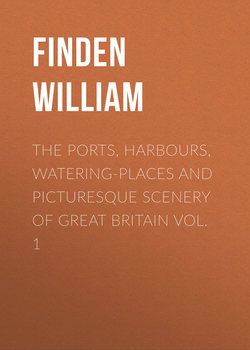The Ports, Harbours, Watering-places and Picturesque Scenery of Great Britain Vol. 1

Реклама. ООО «ЛитРес», ИНН: 7719571260.
Оглавление
Finden William. The Ports, Harbours, Watering-places and Picturesque Scenery of Great Britain Vol. 1
TYNEMOUTH LIGHTHOUSE AND PRIORY
LONDON: THE BRIDGES OF LONDON, SOUTHWARK, AND BLACKFRIARS, FROM THE SURREY SIDE
HARWICH
YARMOUTH
YARMOUTH QUAY
YARMOUTH, WITH NELSON'S PILLAR, (FROM THE LOWESTOFT ROAD)
CROMER
KINGSTON-ON-HULL
BURLINGTON QUAY
FLAMBOROUGH HEAD
SCARBOROUGH
WHITBY
WHITBY, FROM THE NORTH-WEST
ROBIN HOOD'S BAY
HARTLEPOOL
SUNDERLAND, THE LIGHTHOUSE ON THE SOUTH PIER
SUNDERLAND. THE BRIDGE FROM THE WESTWARD
SHIELDS. ENTRANCE TO THE HARBOUR
NEWCASTLE UPON TYNE
BLYTH
TYNEMOUTH. VESSEL ON THE ROCKS
CULLERCOATS
DUNSTANBROUGH CASTLE, FROM THE EASTWARD
DUNSTANBROUGH CASTLE. MOONLIGHT
BAMBROUGH CASTLE. FROM THE SOUTH-EAST
BAMBROUGH CASTLE
CASTLE OF HOLY ISLAND, AND LINDISFARN ABBEY
CASTLE OF HOLY ISLAND. FROM THE WESTWARD
BERWICK. FROM THE SOUTH-EAST
LEITH
NEWHAVEN
DUNDEE. ENTRANCE TO THE PORT
DUNDEE. FROM THE OPPOSITE SIDE OF THE TAY
THE ABBEY OF ARBROATH
MONTROSE
DUNNOTTAR CASTLE
STONEHAVEN
ABERDEEN. GENERAL VIEW
ABERDEEN, FROM ABOVE THE CHAIN BRIDGE
ABERDEEN LIGHTHOUSE
SLAINES CASTLE
THE BULLER OF BUCHAN
PETERHEAD
MACDUFF
BANFF
PORT GLASGOW
GREENOCK
THE BROOMIELAW, GLASGOW
THE SOLWAY FRITH, FROM HARRINGTON PIER
ALLONBY. CUMBERLAND
MARYPORT, CUMBERLAND
MARYPORT PIER
WORKINGTON, CUMBERLAND
WHITEHAVEN, CUMBERLAND
WHITEHAVEN HARBOUR
ST. BEES' COLLEGE
ST. BEES'-HEAD
FLEETWOOD-ON-WYRE, LANCASHIRE
BLACKPOOL
BLACKPOOL. THE SANDS
LYTHAM
SOUTHPORT SANDS. LANCASHIRE
Отрывок из книги
The New London Bridge, which forms so striking a feature in this View, is justly considered the finest specimen of bridge-building in Europe. It is alike the admiration of strangers and natives, and unites in the highest degree the useful and ornamental – elegance of design with solidity of structure. The first pile of this superb structure was driven on the 15th of March, 1824; and on the 27th of April, the following year, the first stone was laid by his Royal Highness the Duke of York, attended by the Lord Mayor, a distinguished party of noblemen, gentlemen, and citizens, and a great concourse of strangers, who had assembled to witness the imposing ceremony. The contracts amounted to five hundred and six thousand pounds, but the total expenditure more than trebled that sum. The clear water-way is six hundred and ninety feet out of seven hundred and eighty-two – the actual width. The carriage-way is thirty-five feet wide, and the foot-paths nine feet each. The central arch, of the five of which it consists, is one hundred and fifty-two feet in span – one of the largest ever known – it is twenty-nine feet and a half in height; and there is no weir, or fall, as in the Old London Bridge. We are thus particular in the measurements that the reader may more readily comprehend the magnificent scale upon which this great national structure has been finished; and it may be an additional facility to this purpose to state, that of granite alone one hundred and twenty thousand tons were consumed in the building.
After six years of incessant labour, it was happily brought to a successful termination under the direction of the late John Rennie, Esq., of whose genius as an architect it is a splendid monument. The opening of the bridge took place on the 1st of August, 1831, and gave occasion to a magnificent festival, which was honoured with the presence of his late Majesty William the Fourth and Queen Adelaide, the Lord Mayor, and all most remarkable for rank and station who were at that time in London. The ceremony was of the most gorgeous and gratifying description; and the water-pageant which accompanied it was the finest ever remembered on the Thames. The bridge was lined with tents and marquees, from which proudly floated the national standard, with numerous flags of societies and corporations, which gave the whole a strikingly gala-like effect. Under these a superb déjeûner, consisting of all the luxuries of the season, was served to the numerous assembly; and, to give additional novelty to the scene, Mr. C. Green, the celebrated aëronaut, ascended from the bridge in his balloon, much to the gratification of the spectators.
.....
The Monument (a conspicuous object on the right hand of the engraving) is a magnificent pillar, erected to commemorate the great fire of the city of London, in 1666, on the spot where it first began. It is of the fluted Doric order, and the material employed in its erection is Portland-stone of the best quality. It is one of the boldest specimens of the kind ever attempted, being two hundred and two feet in height, and fifteen in diameter, and stands on a pedestal forty feet high and twenty-one feet square; and within the shaft is a spiral staircase, consisting of three hundred and forty-five steps, formed of black marble. It was begun in 1671, but not completed till seven years after, as the great demand for stone in the restoration of London and the Cathedral of St. Paul's absorbed nearly all that the Portland quarries could furnish. Mr. Elmes, in his Life of Sir Christopher Wren, informs us that the Monument was at first used by the members of the Royal Society for astronomical experiments; but was abandoned on account of its vibrations being too great for the nicety required in their observations. This occasioned a report – extensively circulated at one time – that it was unsafe; but its sound foundation and scientific construction may bid defiance to all attacks, but those of earthquakes, for centuries to come.
This View of the Metropolis, from Southwark, is exceedingly grand and impressive, and presents a faithful picture of the every-day scenes which are here passing before the eyes of the spectator – dazzling his eye, and filling his mind with those images of unbounded wealth, power, and magnificence, of which there is no precedent in ancient or modern history.
.....